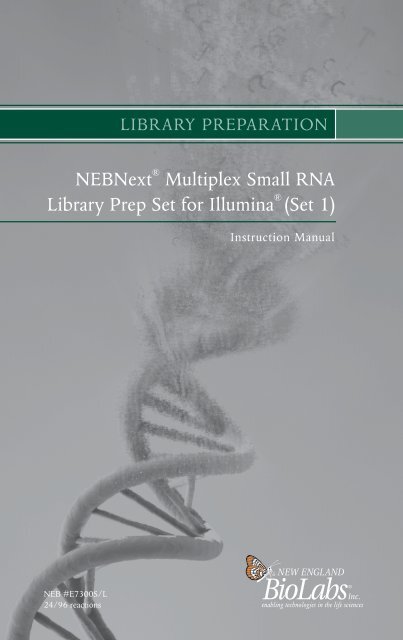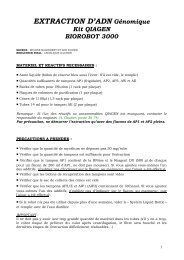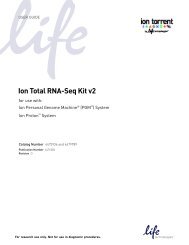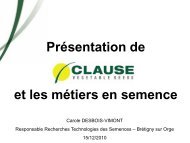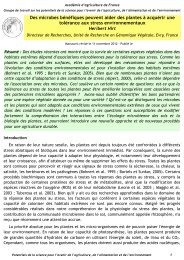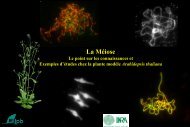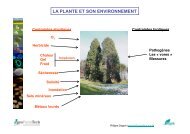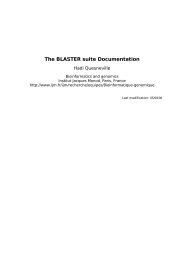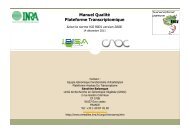manual NEBNext Multiplex Small RNA Library Prep Set for ... - URGV
manual NEBNext Multiplex Small RNA Library Prep Set for ... - URGV
manual NEBNext Multiplex Small RNA Library Prep Set for ... - URGV
You also want an ePaper? Increase the reach of your titles
YUMPU automatically turns print PDFs into web optimized ePapers that Google loves.
Sign up <strong>for</strong> the<strong>NEBNext</strong> e-newsletterScan this code or visit www.neb.com/<strong>NEBNext</strong>news2 to sign up <strong>for</strong> the<strong>NEBNext</strong> bimonthly e-newsletter to learnabout new <strong>NEBNext</strong> products, recentpublications and advances in library prep<strong>for</strong> next gen sequencing.ISO 9001RegisteredQualityManagementISO 14001RegisteredEnvironmentalManagementISO 13485RegisteredMedical DevicesMethods <strong>for</strong> avoidance of adaptor dimer <strong>for</strong>mation are covered by pending patent (New England Biolabs, Inc.).NEW ENGLAND BIOLABS ® , LONGAMP ® , NEBNEXT ® and QUICK-LOAD ® are registered trademarks ofNew England Biolabs, Inc.AMPURE ® is a registered trademark of Beckman Coulter, Inc.BIOANALYZER ® is a registered trademark of Agilent Technologies, Inc.ILLUMINA ® is a registered trademark of Illumina, Inc.CORNING ® , COSTAR ® and SPIN-X ® are registered trademarks of Corning, Inc.NOVEX ® and SYBR ® are registered trademarks of Life Technologies, Inc.PELLET PESTLE ® is a registered trademark of Kimble Kontes Asset Management, Inc.
Protocols:Libraries prepared by this method are compatible with paired-end flow cells.Starting Material: 100 ng–1 µg Total <strong>RNA</strong>.Ligate the 3´ SR AdaptorNote: For total <strong>RNA</strong> inputs of 100 ng, dilute the 3´ SR Adaptor <strong>for</strong> Illumina1:2 in nuclease free water.1. Mix the following components in a sterile nuclease-free PCR tube:Input <strong>RNA</strong> 1–6 µl3´ SR Adaptor <strong>for</strong> Illumina 1 µlNuclease-Free WatervariableTotal volume 7 µl2. Incubate in a preheated thermal cycler <strong>for</strong> 2 minutes at 70°C. Transfertube to ice.3. Add the following Components:3´ Ligation Reaction Buffer (2X) 10 µl3´ Ligation Enzyme Mix 3 µlTotal volume 20 µl4. Incubate <strong>for</strong> 1 hour at 25°C in a thermal cycler.Note: Longer incubation times and reduced temperatures (18 hours;16°C) increase ligation efficiency of methylated <strong>RNA</strong>s such as piwiinteracting<strong>RNA</strong>s (pi<strong>RNA</strong>s) (if present in the sample). However, someconcatamerization products might be <strong>for</strong>med.Hybridize the Reverse Transcription PrimerThis step is important to prevent adaptor-dimer <strong>for</strong>mation. The SR RTPrimer hybridizes to the excess of 3´ SR Adaptor (that remains free after the3´ ligation reaction) and trans<strong>for</strong>ms the single stranded DNA adaptor intoa double-stranded DNA molecule. dsDNAs are not substrates <strong>for</strong> ligationmediated by T4 <strong>RNA</strong> Ligase 1 and there<strong>for</strong>e do not ligate to the 5´ SR Adaptorin the subsequent ligation step.Note: For total <strong>RNA</strong> inputs of 100 ng, dilute the SR RT Primer <strong>for</strong> Illumina1:2 in nuclease free water.5. Add the following components to the ligation mixture from step 4 and mix well:Nuclease-Free Water 4.5 µlSR RT Primer <strong>for</strong> Illumina 1 µl4Total volume now should be 25.5 µl
6. Heat samples <strong>for</strong> 5 minutes at 75°C. Transfer to 37°C <strong>for</strong> 15 minutes,followed by 15 minutes at 25°C.Ligate the 5´ SR Adaptor7. With 5 minutes remaining, resuspend the 5´ SR adaptor in 120 µl ofnuclease free water.Note: For total <strong>RNA</strong> inputs of 100 ng, dilute the 5´ SR Adaptor <strong>for</strong> Illumina1:2 in nuclease free water.8. Aliquot 1.1 N µl of the 5´ SR Adaptor into a separate, nuclease-free 200 µlPCR tube, with N equal to the number of samples being processed <strong>for</strong> thecurrent experiment.9. Incubate the adaptor in the thermal cycler at 70°C <strong>for</strong> 2 minutes andthen immediately place the tube on ice. Keep the tube on ice and use thedenatured adaptor within 30 minutes of denaturation.Note: Store the remaining resuspended 5´ SR adaptor at –80°C.10. Add the following components to the ligation mixture from step 6 and mix well:5´ SR Adaptor <strong>for</strong> Illumina (denatured) 1 µl5´ Ligation Reaction Buffer (10X) 1 µl5´ Ligation Enzyme Mix 2.5 µlTotal volume 30 µl11. Incubate <strong>for</strong> 1 hour at 25°C in a thermal cycler.Per<strong>for</strong>m Reverse Transcription12. Mix the following components in a sterile, nuclease-free tube:Adaptor Ligated <strong>RNA</strong> from Step 11 30 µlFirst Strand Synthesis Reaction Buffer 8 µlMurine RNase Inhibitor 1 µlM-MuLV Reverse Transcriptase (RNase H – ) 1 µlTotal volume 40 µl13. Incubate <strong>for</strong> 60 minutes at 50°C.14. Immediately proceed to PCR amplification.Safe Stopping Point: If you do not plan to proceed immediately to PCRamplification, then heat inactivate the RT reaction at 70°C <strong>for</strong> 15 minutes.Samples can be safely stored at –15°C to –25°C.5
Per<strong>for</strong>m PCR Amplification15. Add the following components to the RT reaction mix from step 14and mix well:LongAmp Taq 2X Master Mix 50 µlSR Primer <strong>for</strong> Illumina 2.5 µlIndex (X) Primer* 2.5 µlNuclease free water 5 µlTotal volume now should be 100 µl*Note: The <strong>NEBNext</strong> <strong>Multiplex</strong> <strong>Small</strong> <strong>RNA</strong> <strong>Library</strong> <strong>Prep</strong> <strong>Set</strong> <strong>for</strong> Illumina(1–12) contains 1–12 PCR primers, each with a different index. For eachreaction, only one of the 12 PCR primer indices is used during the PCR step.PCR Cycling conditions:CYCLE STEP TEMP TIME CYCLESInitial Denaturation 94°C 30 sec 1DenaturationAnnealingExtension94°C62°C70°C15 sec30 sec15 secFinal Extension 70°C 5 min 1Hold 4°C ∞12–15**Amplification conditions may vary based on <strong>RNA</strong> input amount, tissue, and species.This protocol was optimized using 1 µg of total <strong>RNA</strong> from human brain and 12 PCRcycles. The number of PCR cycles can be adjusted if clear and distinct bands are notobserved in the gel image. Run only between 12 and 15 cycles. For 100 ng total <strong>RNA</strong>input run 15 cycles of PCR.Size Selection using AMPure XP BeadsNote: There are two different protocols <strong>for</strong> using AMPure XP beads. One is if youare first cleaning up your sample with a PCR column purification kit. The otheroption is to proceed directly after PCR.1. Purify the PCR amplified cDNA construct (100 µl) using a QIAQuick PCRPurification Kit.IMPORTANT: Be<strong>for</strong>e eluting the DNA from the column, centrifuge the columnwith the lid of the spin column open <strong>for</strong> 5 minutes at 13,200 rpm. Centrifugationwith the lid open ensures that no ethanol remains during DNA elution. It isimportant to dry the spin column membrane of any residual ethanol that mayinterfere with the correct loading of the sample on the PAGE gel.2. Elute amplified DNA in 27.5 µl Nuclease-free Water.63. Load 1 µl of the purified PCR reaction on the Bioanalyzer using a DNA 1000chip according to the manufacturer's instructions (Figure 1).
Figure 1: Typical results from (A) human brain and (B) rat testis total<strong>RNA</strong> libraries be<strong>for</strong>e size selection.A.[FU]706050143150040302010015153 191165 207271-1015 100 200 300 400 700 1,500 [nt]B.[FU]12015310080601500402015186273015 100 300 500 1,500 [nt]The 143 and 153 bp bands correspond to mi<strong>RNA</strong>s and pi<strong>RNA</strong>s, respectively. The bands on the Bionalyzerelectropherograms resolve in sizes ~ 6-8 nucleotides larger than sizes observed on PAGE gels and can shift fromsample to sample due to an incorrect identification of the marker by the bioanalyzer software. mi<strong>RNA</strong> peak shouldbe ~ 143-146 bp.7
Size Select the small <strong>RNA</strong> library using AMPure XP beads after using columnpurification4. To the purified PCR reaction (25 µl), add 32.5 µl (1.3X) of resuspendedAMPure XP beads and mix well on a vortex mixer or by pipetting up anddown at least 10 times.5. Incubate <strong>for</strong> 5 minutes at room temperature.6. Place the tube on an appropriate magnetic stand to separate beads fromsupernatant. After the solution is clear (about 5 minutes), carefully transferthe supernatant (57.5 µl) to a new tube (Caution: do not discard thesupernatant). Discard beads that contain the large DNA fragments.7. Add 92.5 µl (3.7X) of resuspended AMPure XP beads to the supernatant(57.5 µl), mix well and incubate <strong>for</strong> 5 minutes at room temperature.8. Place the tube on an appropriate magnetic stand to separate beads fromsupernatant. After the solution is clear (about 5 minutes), carefully removeand discard the supernatant. Be careful not to disturb the beads that containDNA targets (Caution: do not discard beads).9. Add 200 µl of freshly prepared 80% ethanol to the tube while in themagnetic stand. Incubate at room temperature <strong>for</strong> 30 seconds, and thencarefully remove and discard the supernatant.10. Repeat Step 9 once.11. Briefly spin the tube, and put the tube back in the magnetic stand.12. Completely remove the residual ethanol, and air dry beads <strong>for</strong> 10 minuteswhile the tube is on the magnetic stand with lid open.13. Elute the DNA target from the beads with 15 µl nuclease-free water. Mixwell on a vortex mixer or by pipetting up and down, and put the tube in themagnetic stand until the solution is clear.14. Transfer the supernatant to a clean PCR tube.15. Run 1 µl on the Bioanalyzer High Sensitivity chip. Check peak distributionand molarity of the small <strong>RNA</strong> library.Figure 2: Electropherogram trace of the bead sizeselected purified library from human brain total <strong>RNA</strong>.8
Size Select the small <strong>RNA</strong> library using AMPure XP beads(no column purification)Note: Check the volume of the sample after PCR. Adjust the volume withnuclease free water if necessary to bring the volume up to 100 µl.1. Transfer 100 µl sample to a 1.5 ml tube. Add 130 µl (1.3X) of resuspendedAMPure XP beads and mix well on a vortex mixer or by pipetting up anddown at least 10 times.2. Incubate <strong>for</strong> 5 minutes at room temperature.3. Place the tube on an appropriate magnetic stand to separate the beadsfrom the supernatant. After the solution is clear (about 5 minutes), carefullytransfer the supernatant (230 µl) to a new tube (Caution: do not discardthe supernatant). Discard the beads that contain the large DNA fragments.4. Add 370 µl (3.7X) of resuspended AMPure XP beads to the supernatant(230 µl), mix well and incubate <strong>for</strong> 5 minutes at room temperature.5. Place the tube on an appropriate magnetic stand to separate the beadsfrom the supernatant. After the solution is clear (about 5 minutes), carefullyremove and discard the supernatant. Be careful not to disturb the beadsthat contain DNA targets (Caution: do not discard beads).6. Add 1ml of freshly prepared 80% ethanol to the tube while in the magneticstand. Incubate at room temperature <strong>for</strong> 30 seconds, and then carefullyremove and discard the supernatant.7. Repeat Step 6 once.8. Briefly spin the tube, and put the tube back in the magnetic stand.9. Completely remove the residual ethanol, and air dry beads <strong>for</strong> 10 minuteswhile the tube is on the magnetic stand with lid open.10. Elute the DNA target from the beads with 15 µl of nuclease-free water. Mixwell on a vortex mixer or by pipetting up and down, and put the tube in themagnetic stand until the solution is clear.11. Transfer the supernatant to a clean PCR tube.12. Run 1 µl on the Bioanalyzer High Sensitivity chip. Check peak distributionand molarity of the small <strong>RNA</strong> library.Figure 3: Electropherogram trace of the bead sizeselected library from human brain total <strong>RNA</strong>.9
Alternatively, size select the purified amplified cDNA library on a 6%polyacrylamide gel.1. Mix the purified PCR product (25 µl) with 5 µl of Gel Loading Dye, Blue(6X).2. Load 5 µl of Quick-Load pBR322 DNA-MspI Digest in one well on the 6%PAGE 10-well gel.3. Load two wells with 15 µl each of mixed amplified cDNA construct andloading dye on the 6% PAGE 10-well gel.4. Run the gel <strong>for</strong> 1 hour at 120 V or until the blue dye reaches the bottom ofthe gel. Do not let the blue dye exit the gel.5. Remove the gel from the apparatus and stain the gel with SYBR Goldnucleic acid gel stain in a clean container <strong>for</strong> 2–3 minutes and view the gelon a UV transiluminator (Figure 4).A.bpMolecularMarkerHumanBrainB.bpMolecularMarkerRatTestis62262252752740440430730724221719016014712311090mi<strong>RNA</strong>(~140 bp)242217190160147123110907667pi<strong>RNA</strong>(~150 bp)766710Figure 4: Shows typical results from Human Brain (A) and Rat Testis (B) Total <strong>RNA</strong> libraries.The 140 and 150 bp bands correspond to mi<strong>RNA</strong>s (21 nt) and pi<strong>RNA</strong>s (30 nt), respectively.6. The 140 and 150 nucleotide bands correspond to adapter-ligatedconstructs derived from the 21 and 30 nucleotide <strong>RNA</strong> fragments,respectively. For mi<strong>RNA</strong>s, isolate the bands corresponding to ~140 bp. Forpi<strong>RNA</strong>s, isolate the band corresponding to ~150 bp.7. Place the two gel slices from the same sample in one 1.5 ml tube andcrush the gel slices with the RNase-free Disposable Pellet Pestles and thensoak in 250 µl DNA Gel Elution buffer (1X).
8. Rotate end-to-end <strong>for</strong> at least 2 hours at room temperature.9. Transfer the eluate and the gel debris to the top of a gel filtration column.10. Centrifuge the filter <strong>for</strong> 2 min at > 13,200 rpm.11. Recover eluate and add 1 µl Linear Acrylamide, 25 µl 3M sodium acetate,pH 5.5 and 750 µl of 100% ethanol.12. Vortex well.13. Precipitate in a dry ice/methanol bath or at –80°C <strong>for</strong> at least 30 minutes.14. Spin in a microcentrifuge @ > 14,000 x g <strong>for</strong> 30 minutes at 4°C.15. Remove the supernatant taking care not to disturb the pellet.16. Wash the pellet with 80% ethanol by vortexing vigorously.17. Spin in a microcentrifuge @ > 14,000 x g <strong>for</strong> 30 minutes at 4°C.18. Air dry pellet <strong>for</strong> up to 10 minutes at room temperature to remove residualethanol.19. Resuspend pellet in 12 µl TE Buffer.Validate the <strong>Library</strong>1. Load 1 µl of the size selected purified library on a 2100 Bioanalyzer usinga DNA 1000 or High Sensitivity DNA chip according to the manufacturer'sinstructions (Figure 5).2. Check the size, purity, and concentration of the sample.Figure 5: Electropherogram trace of the gel size selected purified libraryfrom human brain total <strong>RNA</strong>.[FU]1,00014750003510,38012,63440 50 60 70 80 90 100 110 120 130 [s]11
<strong>NEBNext</strong> 3´ Ligation Reaction Buffer#E7301A: 0.24 ml Concentration: 2X#E7301AA: 0.96 mlStore at –20°CQuality Control Assays16-Hour Incubation: 50 µl reactions containing 3´ Ligation Reaction Bufferat 1X concentration and 1 µg of HindIII digested Lambda DNA incubated <strong>for</strong>16 hours at 37°C results in no detectable non-specific nuclease degradationas determined by agarose gel electrophoresis. 50 µl reactions containing thisreaction buffer at 1X concentration and 1 µg T3 DNA incubated <strong>for</strong> 16 hoursat 37°C also results in no detectable non-specific nuclease degradation asdetermined by agarose gel electrophoresis.Endonuclease Activity: Incubation of a 50 µl reaction containing 1X 3´ LigationReaction Buffer with 1 µg of φX174 RF I DNA in assay buffer <strong>for</strong> 4 hours at37°C results in less than 10% conversion to RF II as determined by agarose gelelectrophoresis.Phosphatase Activity: Incubation of 1X 3´ Ligation Reaction Buffer in proteinphosphatase assay buffer (1 M diethanolamine @ pH 9.8 and 0.5 mM MgCl 2)containing 2.5 mM p-nitrophenyl phosphate at 37°C <strong>for</strong> 4 hours yields nodetectable p-nitrophenylene anion as determined by spectrophotometricanalysis at 405 nm.RNase Activity: Incubation of a 10 µl reaction of 3´ Ligation Reaction Buffer at1X concentration with 40 ng of a FAM-labeled <strong>RNA</strong> transcript <strong>for</strong> 16 hours at37°C results in no detectable RNase activity as determined by polyacrylamidegel electrophoresis.Lot Controlled12
<strong>NEBNext</strong> 3´ Ligation Enzyme Mix#E7302A: 0.072 ml#E7302AA: 0.288 mlStore at –20°CDescription: <strong>NEBNext</strong> 3´ Ligation Enzyme Mix has been optimized to ligate shortsingle-stranded <strong>RNA</strong>s (17–30 nucleotide length) to a 5´-adenylated, 3´-blockedsingle-stranded DNA adaptor in 1X <strong>NEBNext</strong> 3´ Ligation Reaction Buffer at 25°C.Quality Control AssaysSDS-PAGE Purity: SDS-PAGE analysis of this enzyme indicates > 95% enzymepurity.16-Hour Incubation: 50 µl reactions containing 1 µl of 3´ Ligation EnzymeMix and 1 µg of HindIII digested Lambda DNA incubated <strong>for</strong> 16 hours at 37°Cresults in no detectable non-specific nuclease degradation as determined byagarose gel electrophoresis. 50 µl reactions containing 1 µl of 3´ LigationEnzyme Mix and 1 µg T3 DNA incubated <strong>for</strong> 16 hours at 37°C also results inno detectable non-specific nuclease degradation as determined by agarose gelelectrophoresis.Endonuclease Activity: Incubation of a 50 µl reaction containing 1 µl 3´ LigationEnzyme Mix with 1 µg of φX174 RF I DNA <strong>for</strong> 4 hours at 37°C results in lessthan 10% conversion to RF II as determined by agarose gel electrophoresis.Phosphatase Activity: Incubation of a minimum of 1 µl 3´ Ligation Enzyme Mixin protein phosphatase assay buffer (1 M diethanolamine @ pH 9.8 and 0.5 mMMgCl 2) containing 2.5 mM p-nitrophenyl phosphate at 37°C <strong>for</strong> 4 hours yieldsno detectable p-nitrophenylene anion as determined by spectrophotometricanalysis at 405 nm.RNase Activity: Incubation of a 10 µl reaction containing 1 µl 3´ LigationEnzyme Mix with 40 ng of a FAM-labeled <strong>RNA</strong> transcript <strong>for</strong> 16 hours at 37°Cresults in no detectable RNase Activity as determined by polyacrylamide gelelectrophoresis.Functional Activity: 200 units of T4 <strong>RNA</strong> Ligase2, truncated, ligates 80% ofa 31-mer <strong>RNA</strong> to the pre-adenylated end of a 17-mer DNA [Universal mi<strong>RNA</strong>Cloning Linker (NEB #S1315)] in a total reaction volume of 10 µl in 1 hourat 25°C. Unit assay conditions: 1X Reaction Buffer (50 mM Tris-HCl, 10 mMMgCl 2, 1 mM DTT, pH 7.5 @ 25°C) supplemented to 10% (w/v) PEG MW4000, 5 pmol of 5´-FAM labeled <strong>RNA</strong>, and 10 pmol preadenylated DNA linker.After incubation at 25°C <strong>for</strong> 1 hour, the ligated product is detected on a 15%denaturing polyacrylamide gel.One unit of Murine RNase Inhibitor inhibits the activity of the 5 ng of RNase Aby 50%. Activity is measured by the inhibition of hydrolysis of cytidine 2, 3´ –cyclic monophosphate by RNase A.Lot Controlled13
<strong>NEBNext</strong> 3´ SR Adaptor <strong>for</strong> Illumina#E7332A:#E7332AA:Store at –20°C0.024 ml0.096 mlDescription: 5´ adenylated, 3´ blocked oligodeoxynucleotideSequence: 5´-rAppAGATCGGAAGAGCACACGTCT-NH 2-3´Quality Control Assays16-Hour Incubation: 50 µl reactions containing 1 µl <strong>NEBNext</strong> 3´ SR Adaptor and1 µg of HindIII digested Lambda DNA incubated <strong>for</strong> 16 hours at 37°C results inno detectable non-specific nuclease degradation as determined by agarose gelelectrophoresis. 50 µl reactions containing 1 µl <strong>NEBNext</strong> 3´ SR Adaptor and 1µg of T3 DNA incubated <strong>for</strong> 16 hours at 37°C results in no detectable nonspecificnuclease degradation as determined by agarose gel electrophoresis.Endonuclease Activity: Incubation of a 50 µl reaction containing 1 µl <strong>NEBNext</strong>3´ SR Adaptor with 1 µg of φX174 RF I supercoiled DNA <strong>for</strong> 4 hours at 37°Cresults in less than 10% conversion to RF II as determined by agarose gelelectrophoresis.RNase Activity: Incubation of a 10 µl reaction containing 1 µl <strong>NEBNext</strong> 3´SR Adaptor with 40 ng of <strong>RNA</strong> transcript <strong>for</strong> 16 hours at 37°C resulted in nodetectable degradation of <strong>RNA</strong> as determined by gel electrophoresis.Phosphatase Activity: Incubation of 1 µl <strong>NEBNext</strong> 3´ SR Adaptor in proteinphosphatase assay buffer (1 M diethanolamine @ pH 9.8 and 0.5 mM MgCl 2)containing 2.5 mM p-nitrophenyl phosphate at 37°C <strong>for</strong> 4 hours yields nodetectable p-nitrophenylene anion as determined by spectrophotometricanalysis at 405 nm.HPLC: <strong>NEBNext</strong> 3´ SR Adaptor purity is determined by HPLC to be > 99%.Lot Controlled14
<strong>NEBNext</strong> 5´ SR Adaptor <strong>for</strong> Illumina#E7328A:Store at –20°C1350 pmolSequence: 5´- rGrUrUrCrArGrArGrUrUrCrUrArCrArGrUrCrCrGrArCrGrArUrC-3´Quality Control Assays16-Hour Incubation: 50 µl reactions containing 1 µl <strong>NEBNext</strong> 5´ SR Adaptor and1 µg of HindIII digested Lambda DNA incubated <strong>for</strong> 16 hours at 37°C results inno detectable non-specific nuclease degradation as determined by agarose gelelectrophoresis. 50 µl reactions containing 1 µl <strong>NEBNext</strong> 5´ SR Adaptor and 1µg of T3 DNA incubated <strong>for</strong> 16 hours at 37°C results in no detectable nonspecificnuclease degradation as determined by agarose gel electrophoresis.Endonuclease Activity: Incubation of a 50 µl reaction containing 1 µl <strong>NEBNext</strong>5´ SR Adaptor with 1 µg of φX174 RF I supercoiled DNA <strong>for</strong> 4 hours at 37°Cresults in less than 10% conversion to RF II as determined by agarose gelelectrophoresis.RNase Activity: Incubation of a 10 µl reaction containing 1 µl <strong>NEBNext</strong> 5´SR Adaptor with 40 ng of <strong>RNA</strong> transcript <strong>for</strong> 16 hours at 37°C resulted in nodetectable degradation of <strong>RNA</strong> as determined by gel electrophoresis.Phosphatase Activity: Incubation of 1 µl <strong>NEBNext</strong> 5´ SR Adaptor in proteinphosphatase assay buffer (1 M diethanolamine @ pH 9.8 and 0.5 mM MgCl 2)containing 2.5 mM p-nitrophenyl phosphate at 37°C <strong>for</strong> 4 hours yields nodetectable p-nitrophenylene anion as determined by spectrophotometricanalysis at 405 nm.HPLC: <strong>NEBNext</strong> 5´ SR Adaptor purity is determined by HPLC to be > 99%.Lot Controlled15
<strong>NEBNext</strong> 5´ Ligation Reaction Buffer#E7304A:#E7304AA:Store at –20°C0.024 ml0.096 mlQuality Control Assays16-Hour Incubation: 50 µl reactions containing 1X 5´ Ligation Reaction Bufferand 1 µg of HindIII digested Lambda DNA incubated <strong>for</strong> 16 hours at 37°C resultsin no detectable non-specific nuclease degradation as determined by agarosegel electrophoresis. 50 µl reactions containing 1X 5´ Ligation Reaction Bufferand 1 µg of T3 DNA incubated <strong>for</strong> 16 hours at 37°C results in no detectable nonspecificnuclease degradation as determined by agarose gel electrophoresis.Endonuclease Activity: Incubation of a 50 µl reaction containing 1X 5´ LigationReaction Buffer with 1 µg of φX174 RF I supercoiled DNA <strong>for</strong> 4 hours at 37°Cresults in less than 10% conversion to RF II as determined by agarose gelelectrophoresis.Phosphatase Activity: Incubation of 1X 5´ Ligation Reaction Buffer in proteinphosphatase assay buffer (1 M diethanolamine @ pH 9.8 and 0.5 mM MgCl 2)containing 2.5 mM p-nitrophenyl phosphate at 37°C <strong>for</strong> 4 hours yields nodetectable p-nitrophenylene anion as determined by spectrophotometric analysisat 405 nm.RNase Activity: Incubation of a 10 µl reaction containing 1X 5´ LigationReaction Buffer with 40 ng of a FAM-labeled <strong>RNA</strong> transcript <strong>for</strong> 16 hours at 37°Cresulted in no detectable degradation of <strong>RNA</strong> as determined by polyacrylamidegel electrophoresis.Lot Controlled16
<strong>NEBNext</strong> 5´ Ligation Enzyme Mix#E7305A:#E7305AA:Store at –20°C0.06 ml0.24 mlDescription: <strong>NEBNext</strong> 5´ Ligation Enzyme Mix has been optimized to ligate shortsingle-stranded <strong>RNA</strong>s (17–30 nucleotide length) in 1X <strong>NEBNext</strong> 5´ LigationReaction Buffer at 25°C.Quality Control AssaysSDS-PAGE Purity: SDS-PAGE analysis of this enzyme indicates > 95% enzymepurity.16-Hour Incubation: 50 µl reactions containing 1 µl of 5´ Ligation Enzyme Mixand 1 µg of HindIII digested Lambda DNA incubated <strong>for</strong> 16 hours at 37°C resultsin no detectable non-specific nuclease degradation as determined by agarosegel electrophoresis. 50 µl reactions containing 1 µl of 5´ Ligation Enzyme Mixand 1 µg of T3 DNA incubated <strong>for</strong> 16 hours at 37°C results in no detectable nonspecificnuclease degradation as determined by agarose gel electrophoresis.Endonuclease Activity: Incubation of a 50 µl reaction containing 1 µl 5´ LigationEnzyme Mix with 1 µg of φX174 RF I supercoiled DNA <strong>for</strong> 4 hours at 37°Cresults in less than 10% conversion to RF II as determined by agarose gelelectrophoresis.Phosphatase Activity: Incubation of a minimum of 1 µl 5´ Ligation Enzyme Mixin protein phosphatase assay buffer (1 M diethanolamine @ pH 9.8 and 0.5 mMMgCl 2) containing 2.5 mM p-nitrophenyl phosphate at 37°C <strong>for</strong> 4 hours yieldsno detectable p-nitrophenylene anion as determined by spectrophotometricanalysis at 405 nm.Functional Activity: One unit of T4 <strong>RNA</strong> Ligase 1 is defined as the amount ofenzyme required to convert 1 nmol of 5´-[ 32 P] rA16 into a phosphatase-resistant<strong>for</strong>m in 30 minutes at 37°C.One unit of Murine Inhibitor inhibits the activity of 5 ng of RNase A by 50%.Activity is measured by the inhibition of hydrolysis of cytidine 2, 3´-cyclicmonophosphate by RNase A.Lot Controlled17
<strong>NEBNext</strong> SR RT Primer <strong>for</strong> Illumina#E7333A:#E7333AA:Store at –20°C0.024 ml0.096 mlSequence: 5´-AGACGTGTGCTCTTCCGATCT-3´Quality Control Assays16-Hour Incubation: 50 µl reactions containing 1 µl <strong>NEBNext</strong> SR RT Primer and1 µg of HindIII digested Lambda DNA incubated <strong>for</strong> 16 hours at 37°C results inno detectable non-specific nuclease degradation as determined by agarose gelelectrophoresis. 50 µl reactions containing <strong>NEBNext</strong> SR RT Primer and 1 µg ofT3 DNA incubated <strong>for</strong> 16 hours at 37°C results in no detectable non-specificnuclease degradation as determined by agarose gel electrophoresis.Endonuclease Activity: Incubation of a 50 µl reaction containing 1 µl <strong>NEBNext</strong>SR RT Primer with 1 µg of φX174 RF I supercoiled DNA <strong>for</strong> 4 hours at 37°Cresults in less than 10% conversion to RF II as determined by agarose gelelectrophoresis.RNase Activity: Incubation of a 10 µl reaction containing 1 µl <strong>NEBNext</strong> SRRT Primer with 40 ng of <strong>RNA</strong> transcript <strong>for</strong> 16 hours at 37°C resulted in nodetectable degradation of <strong>RNA</strong> as determined by gel electrophoresis.Phosphatase Activity: Incubation of 1 µl <strong>NEBNext</strong> SR RT Primer in proteinphosphatase assay buffer (1 M diethanolamine @ pH 9.8 and 0.5 mM MgCl 2)containing 2.5 mM p-nitrophenyl phosphate at 37°C <strong>for</strong> 4 hours yields nodetectable p-nitrophenylene anion as determined by spectrophotometricanalysis at 405 nm.Lot Controlled18
<strong>NEBNext</strong> First Strand Synthesis Reaction Buffer#E7334A: 0.192 ml Concentration: 5X#E7334AA: 0.768 mlStore at –20°CQuality Control Assays16-Hour Incubation: 50 µl reactions containing 1X First Strand SynthesisReaction Buffer and 1 µg of HindIII digested Lambda DNA incubated <strong>for</strong> 16hours at 37°C results in no detectable non-specific nuclease degradation asdetermined by agarose gel electrophoresis. 50 µl reactions containing 1XFirst Strand Synthesis Reaction Buffer and 1 µg of T3 DNA incubated <strong>for</strong> 16hours at 37°C results in no detectable non-specific nuclease degradation asdetermined by agarose gel electrophoresis.Endonuclease Activity: Incubation of a 10 µl reaction containing 1X FirstStrand Synthesis Reaction Buffer with 1 µg of φX174 RF I supercoiled DNA <strong>for</strong>4 hours at 37°C results in < 10% conversion to RF II (nicked molecules) asdetermined by gel electrophoresis.RNase Activity: Incubation of a 10 µl reaction containing 1X First StrandSynthesis Reaction Buffer with 40 ng of <strong>RNA</strong> transcript <strong>for</strong> 16 hours at37°C resulted in no detectable degradation of <strong>RNA</strong> as determined by gelelectrophoresis.Phosphatase Activity: Incubation of 1X First Strand Synthesis ReactionBuffer in protein phosphatase assay buffer (1 M diethanolamine @ pH 9.8and 0.5 mM MgCl 2) containing 2.5 mM p-nitrophenyl phosphate at 37°C<strong>for</strong> 4 hours yields no detectable p-nitrophenylene anion as determined byspectrophotometric analysis at 405 nm.Lot Controlled19
M-MuLV Reverse Transcriptase (RNase H – )#E7355A: 0.024 ml Concentration: 200,000 U/ml#E7355AA: 0.096 mlStore at –20°CDescription: M-MuLV Reverse Transcriptase (RNase H – ) is a recombinantM-MuLV reverse transcriptase with reduced RNase H activity and increasedthermostability. It can be used to synthesize first strand cDNA at highertemperatures than the wild type M-MuLV. The enzyme is active up to 50°C,providing higher specificity, higher yield of cDNA and more full-length cDNAproduct up to 12 kb.Source: The gene encoding a mutant M-MuLV Reverse Transcriptase(RNase H – ) is expressed in E. coli and purified to near homogeneity.Quality Control Assays16-Hour Incubation: A 50 µl reaction containing 1 µg of φX174 DNA and100 units of M-MuLV Reverse Transcriptase (RNase H – ) incubated <strong>for</strong>16 hours at 37°C resulted in a DNA pattern free of detectable nucleasedegradation as determined by agarose gel electrophoresis.Exonuclease Activity: Incubation of a 50 µl reaction containing 100 units ofM-MuLV Reverse Transcriptase (RNase H – ) with 1 µg of a mixture of singleand double-stranded [ 3 H] E. coli DNA (10 5 cpm/µg) <strong>for</strong> 4 hours at 37°Creleased < 0.2% of the total radioactivity.RNase Activity: Incubation of a 10 µl reaction containing 100 units of M-MuLVReverse Transcriptase (RNase H – ) with 40 ng of <strong>RNA</strong> transcripts <strong>for</strong> 2 hoursat 37°C resulted in no detectable degradation of the <strong>RNA</strong> as determined by gelelectrophoresis.Phosphatase Activity: Incubation of 100 units of M-MuLV ReverseTranscriptase (RNase H – ) in protein phosphatase assay buffer containing2.5 mM p-nitrophenyl phosphate at 37°C <strong>for</strong> 4 hours yields no detectablep-nitrophenylene anion as determined by spectrophotometric analysis at405 nm.Protein Purity (SDS-PAGE): M-MuLV Reverse Transcriptase (RNase H – ) is> 95% pure as determined by SDS PAGE analysis using Coomassie bluedetection.Lot Controlled20
Murine RNase Inhibitor#E7308A: 0.024 ml#E7308AA: 0.096 mlStore at –20°CDescription: Murine RNase inhibitor is a 50 kDa recombinant protein of murine origin. The inhibitorspecifically inhibits RNases A, B and C. It inhibits RNases by binding noncovalently in a 1:1 ratio withhigh affinity. It is not effective against RNase 1, RNase T1, S1 Nuclease, RNase H or RNase fromAspergillus. In addition, no inhibition of polymerase activity is observed when RNase Inhibitor is usedwith Taq DNA Polymerase, AMV or M-MuLV Reverse Transcriptases, or Phage <strong>RNA</strong> Polymerases(SP6, T7, or T3).Recombinant murine RNase inhibitor does not contain the pair of cysteines identified in the humanversion that is very sensitive to oxidation, which causes inactivation of the inhibitor (1). As a result,Murine RNase Inhibitor has significantly improved resistance to oxidation compared to the human/porcine RNase inhibitors, even under conditions where the DTT concentration is low. There<strong>for</strong>e, it isadvantageous to use murine RNase inhibitor in reactions where high concentration DTT is adverse tothe reaction (eg. Real-time RT-PCR).Source: An E. coli strain that carries the ribonuclease inhibitor gene from mouseSupplied in: 20 mM HEPES-KOH, 50 mM KCl, 8 mM DTT and 50% glycerolQuality Control Assays16-Hour Incubation: 50 µl reactions containing a minimum of 40 units of Murine RNase Inhibitorand 1 µg of HindIII digested Lambda DNA incubated <strong>for</strong> 16 hours at 37°C results in no detectablenon-specific nuclease degradation as determined by agarose gel electrophoresis. 50 µl reactionscontaining a minimum of 40 units of Murine RNase Inhibitor and 1 µg of T3 DNA incubated <strong>for</strong> 16hours at 37°C results in no detectable non-specific nuclease degradation as determined by agarosegel electrophoresis.Exonuclease Activity: Incubation of a 50 µl reaction containing 200 units of Murine RNase Inhibitorwith 1 µg of a mixture of single and double-stranded [ 3 H] E. coli DNA (20 5 cpm/µg) <strong>for</strong> 4 hours at37°C released < 0.5% of the total radioactivity.Latent RNase Assay: Heating the Murine RNase Inhibitor <strong>for</strong> 20 minutes at 65°C, followed byincubation of a 10 µl reaction containing 40 units of RNase Inhibitor with 40 ng of <strong>RNA</strong> transcript <strong>for</strong>4 hours at 37°C resulted in no detectable degradation of <strong>RNA</strong> as determined by gel electrophoresis.RNase Activity: Incubation of a 10 µl reaction containing 40 units of Murine RNase Inhibitor with40 ng of <strong>RNA</strong> transcript <strong>for</strong> 16 hours at 37°C resulted in no detectable degradation of <strong>RNA</strong> asdetermined by gel electrophoresis.Endonuclease Activity: Incubation of a 10 µl reaction containing 40 units of Murine RNase Inhibitorwith 1 µg of φX174 RF I supercoiled DNA <strong>for</strong> 4 hours at 37°C results in < 10% conversion to RF II(nicked molecules) as determined by gel electrophoresis.Phosphatase Activity: Incubation of a minimum of 40 units of Murine RNase Inhibitor in proteinphosphatase assay buffer (1 M diethanolamine @ pH 9.8 and 0.5 mM MgCl 2) containing 2.5 mMp-nitrophenyl phosphate at 37°C <strong>for</strong> 4 hours yields no detectable p-nitrophenylene anion as determinedby spectrophotometric analysis at 405 nm.Functional Activity: One unit of Murine RNase Inhibitor inhibits the activity of 5 ng of RNase A by50%. Activity is measured by the inhibition of hydrolysis of cytidine 2, 3'-cyclic monophosphate byRNase A.Lot ControlledReferences:1. Kim, B.M. et al. (1999). Protein Science, 8, 430–434.21
LongAmp Taq 2X Master Mix#E7309A: 1.2 ml Concentration: 2X#E7309AA: 4.8 mlStore at –20°CQuality Control AssaysSDS-PAGE Purity: SDS-PAGE analysis of this enzyme indicates > 95% enzyme purity.16-Hour Incubation: 50 µl reactions containing 1 µl of LongAmp Taq 2X Master Mixand 1 µg of HindIII digested Lambda DNA incubated <strong>for</strong> 16 hours at 37°C resultsin no detectable non-specific nuclease degradation as determined by agarose gelelectrophoresis. 50 µl reactions containing 1 µl of LongAmp Taq 2X Master Mix and 1 µgof T3 DNA incubated <strong>for</strong> 16 hours at 37°C results in no detectable non-specific nucleasedegradation as determined by agarose gel electrophoresis.Endonuclease Activity: Incubation of a minimum of 10 µl of LongAmp Taq 2X Master Mixwith 1 µg of φX174 RF I supercoiled DNA <strong>for</strong> 4 hours at 37°C results in less than 10%conversion to RF II as determined by agarose gel electrophoresis.RNase Activity: Incubation of a 10 µl reaction containing 1 µl of LongAmp Taq 2X MasterMix with 40 ng of a FAM-labeled <strong>RNA</strong> transcript <strong>for</strong> 16 hours at 37°C resulted in nodetectable degradation of <strong>RNA</strong> as determined by polyacrylamide gel electrophoresis.Phosphatase Activity: Incubation of a minimum of 10 µl of LongAmp Taq 2X Master Mixin protein phosphatase assay buffer (1 M diethanolamine @ pH 9.8 and 0.5 mM MgCl 2)containing 2.5 mM p-nitrophenyl phosphate at 37°C <strong>for</strong> 4 hours yields no detectablep-nitrophenylene anion as determined by spectrophotometric analysis at 405 nm.Functional Activity: One unit of LongAmp Taq DNA Polymerase is defined as the amountof enzyme that will incorporate 10 nmol of dNTP into acid-insoluble material in 1XThermoPol Reaction Buffer, 200 µM dNTPs including [ 3 H]-dTTP and 200 µg/ml activatedCalf Thymus DNA; in 30 minutes at 65°C.Lot ControlledLimited Label License: This product is covered by certain patents outside the United States (the "Non-US Patents")corresponding to the expired U.S. Patent No. 5,436,149 (claims 6-16). The purchase of this product conveys to thepurchaser only the limited, non-transferable right under the Non-US Patents to use the purchased quantity of theproduct <strong>for</strong> the purchaser's own research by the purchaser only. No rights are granted to the purchaser with respectto the Non-US Patents to sell, modify <strong>for</strong> resale or otherwise transfer this product, either alone or as a component ofanother product, to any third party. Takara Bio reserves all other rights to the Non-US Patents, and this product may notbe used in any manner other than as provided herein. For in<strong>for</strong>mation on obtaining a license with respect to the Non-USPatents to use this product <strong>for</strong> purposes other than research, please contact Takara Bio Inc., <strong>Set</strong>a 3-4-1, Otsu, Shiga520-2193, Japan (Fax +81-77-543-9254).22
<strong>NEBNext</strong> SR Primer <strong>for</strong> Illumina#E7310A: 0.060 ml#E7310AA: 0.240 mlStore at –20°CSequence: 5´-AATGATACGGCGACCACCGAGATCTACACGTTCAGAGTTCTACAGTCCG-s-A-3´Where -s- indicates phosphorothioate bond.Quality Control Assays16-Hour Incubation: 50 µl reactions containing 1 µl <strong>NEBNext</strong> SR Primer and 1µg of HindIII digested Lambda DNA incubated <strong>for</strong> 16 hours at 37°C results inno detectable non-specific nuclease degradation as determined by agarose gelelectrophoresis. 50 µl reactions containing <strong>NEBNext</strong> SR Primer <strong>for</strong> Illumina and1 µg of T3 DNA incubated <strong>for</strong> 16 hours at 37°C results in no detectable nonspecificnuclease degradation as determined by agarose gel electrophoresis.Endonuclease Activity: Incubation of a 50 µl reaction containing 1 µl <strong>NEBNext</strong>SR Primer with 1 µg of φX174 RF I supercoiled DNA <strong>for</strong> 4 hours at 37°Cresults in less than 10% conversion to RF II as determined by agarose gelelectrophoresis.RNase Activity: Incubation of a 10 µl reaction containing 1 µl <strong>NEBNext</strong> SRPrimer with 40 ng of <strong>RNA</strong> transcript <strong>for</strong> 16 hours at 37°C resulted in nodetectable degradation of <strong>RNA</strong> as determined by gel electrophoresis.Phosphatase Activity: Incubation of 1 µl <strong>NEBNext</strong> SR Primer in proteinphosphatase assay buffer (1 M diethanolamine @ pH 9.8 and 0.5 mM MgCl 2)containing 2.5 mM p-nitrophenyl phosphate at 37°C <strong>for</strong> 4 hours yields nodetectable p-nitrophenylene anion as determined by spectrophotometric analysisat 405 nm.23
Gel Loading Dye, Blue#E6138A: 0.2 ml Concentration: 6X#E6138AA: 1 mlStore at 25°CDescription: Gel Loading Dye, Blue (6X) is a pre-mixed loading bufferwith a tracking dye <strong>for</strong> agarose and non-denaturing poylacrylamide gelelectrophoresis. This solution contains SDS, which often results in sharperbands, as some enzymes are known to remain bound to their DNA substratesfollowing cleavage. EDTA is also included to chelate magnesium (up to10 mM) in enzymatic reactions, thereby stopping the reaction. BromophenolBlue migrates at approximately 300 bp on a standard 1% TBE agarose gel.Quality Control Assays16-Hour Incubation: 50 µl reactions containing 1X Gel Loading Dye and 1 µgof HindIII digested Lambda DNA incubated <strong>for</strong> 16 hours at 37°C results in nodetectable non-specific nuclease degradation as determined by agarose gelelectrophoresis. 50 µl reactions containing 1X Gel Loading Dye and 1 µg ofT3 DNA incubated <strong>for</strong> 16 hours at 37°C results in no detectable non-specificnuclease degradation as determined by agarose gel electrophoresis.Endonuclease Activity: Incubation of a 50 µl reaction containing 1X GelLoading Dye with 1 µg of φX174 RF I supercoiled DNA <strong>for</strong> 4 hours at 37°Cresults in less than 10% conversion to RF II (nicked molecules) as determinedby agarose gel electrophoresis.RNase Activity: Incubation of a 10 µl reaction containing 1X Gel Loading Dyewith 40 ng of <strong>RNA</strong> transcript <strong>for</strong> 16 hours at 37°C resulted in no detectabledegradation of <strong>RNA</strong> as determined by gel electrophoresis.Phosphatase Activity: Incubation of 1X Gel Loading Dye in proteinphosphatase assay buffer (1 M diethanolamine @ pH 9.8 and 0.5 mM MgCl 2)containing 2.5 mM p-nitrophenyl phosphate at 37°C <strong>for</strong> 4 hours yields nodetectable p-nitrophenylene anion as determined by spectrophotometricanalysis at 405 nm.Lot Controlled24
Quick-Load pBR322 MspI-DNA Digest#E7323A: 0.24 ml Concentration: 50 µg/ml#E7323AA: 0.96 mlStore at –20°C or 4°CDescription: Quick-Load pBR322 DNA-MspI Digest is a pre-mixed, ready toload molecular weight marker containing Bromophenol Blue as a tracking dye.The MspI Digest of pBR322 DNA yields 26 fragments.The double-strandedDNA is digested to completion with MspI, phenol extracted, and equilibratedto 10 mM Tris-HCl (pH 8.0) and 1 mM EDTA.Fragment Size (bp)1 6222 5273 4044 3075 2426 2387 2178 2019 19010 18011,12 16013,14 14715 12316 11017 9018 7619 6720,21 3422,23 2624 1525,26 925
Quick-Load pBR322 MspI-DNA Digest (Cont.)Quality Control Assays16-Hour Incubation: 50 µl reactions containing 1 µl Quick-Load pBR322MspI DNA Digest and 1 µg of HindIII digested Lambda DNA incubated <strong>for</strong> 16hours at 37°C results in no detectable non-specific nuclease degradation asdetermined by agarose gel electrophoresis. 50 µl reactions containing 1 µlQuick-Load pBR322 MspI DNA Digest and 1 µg of T3 DNA incubated <strong>for</strong> 16hours at 37°C results in no detectable non-specific nuclease degradation asdetermined by agarose gel electrophoresis.Endonuclease Activity: Incubation of a 50 µl reaction containing 1 µl Quick-Load pBR322 MspI DNA Digest with 1 µg of φX174 RF I supercoiled DNA <strong>for</strong> 4hours at 37°C results in less than 10% conversion to RF II (nicked molecules)as determined by agarose gel electrophoresis.RNase Activity: Incubation of a 10 µl reaction containing 1 µl Quick-LoadpBR322 MspI DNA Digest with 40 ng of <strong>RNA</strong> transcript <strong>for</strong> 16 hours at37°C resulted in no detectable degradation of <strong>RNA</strong> as determined by gelelectrophoresis.Phosphatase Activity: Incubation of Quick-Load pBR322 MspI DNA Digest inprotein phosphatase assay buffer (1 M diethanolamine @ pH 9.8 and 0.5 mMMgCl 2) containing 2.5 mM p-nitrophenyl phosphate at 37°C <strong>for</strong> 4 hours yieldsno detectable p-nitrophenylene anion as determined by spectrophotometricanalysis at 405 nm.Lot Controlled26
DNA Gel Elution Buffer#E7324A: 12 ml Concentration: 1X#E7324AA: 48 mlStore at –20°C or 4°CDescription: DNA Gel Elution Buffer is provided <strong>for</strong> the extraction of the sizeselected amplified cDNA library from the polyacrylamide gel.Quality Control Assays16-Hour Incubation: 50 µl reactions containing 10 µl DNA Gel Elution Buffer and1 µg of HindIII digested Lambda DNA incubated <strong>for</strong> 16 hours at 37°C results inno detectable non-specific nuclease degradation as determined by agarose gelelectrophoresis. 50 µl reactions containing 10 µl DNA Gel Elution Buffer and 1 µgof T3 DNA incubated <strong>for</strong> 16 hours at 37°C results in no detectable non-specificnuclease degradation as determined by agarose gel electrophoresis.Endonuclease Activity: Incubation of a 50 µl reaction containing 10 µl DNA GelElution Buffer with 1 µg of φX174 RF I supercoiled DNA <strong>for</strong> 4 hours at 37°Cresults in less than 10% conversion to RF II (nicked molecules) as determined byagarose gel electrophoresis.RNase Activity: Incubation of a 10 µl reaction containing 1 µl DNA Gel ElutionBuffer with 40 ng of <strong>RNA</strong> transcript <strong>for</strong> 16 hours at 37°C resulted in no detectabledegradation of <strong>RNA</strong> as determined by gel electrophoresis.Phosphatase Activity: Incubation of DNA Gel Elution Buffer in proteinphosphatase assay buffer (1 M diethanolamine @ pH 9.8 and 0.5 mM MgCl 2)containing 2.5 mM p-nitrophenyl phosphate at 37°C <strong>for</strong> 4 hours yields nodetectable p-nitrophenylene anion as determined by spectrophotometric analysisat 405 nm.Lot Controlled27
Linear Acrylamide#E7325A: 0.048 ml Concentration: 10 mg/ml#E7325AA: 0.192 mlStore at –20°C or 4°CQuality Control Assays16-Hour Incubation: 50 µl reactions containing 1 µg Linear Acrylamide and1 µg of HindIII digested Lambda DNA incubated <strong>for</strong> 16 hours at 37°C results inno detectable non-specific nuclease degradation as determined by agarose gelelectrophoresis. 50 µl reactions containing 1 µg Linear Acrylamide and 1 µg ofT3 DNA incubated <strong>for</strong> 16 hours at 37°C results in no detectable non-specificnuclease degradation as determined by agarose gel electrophoresis.Endonuclease Activity: Incubation of a 50 µl reaction containing 1 µg LinearAcrylamide with 1 µg of φX174 RF I supercoiled DNA <strong>for</strong> 4 hours at 37°Cresults in less than 10% conversion to RF II (nicked molecules) as determinedby agarose gel electrophoresis.RNase Activity: Incubation of a 10 µl reaction containing 1 µg LinearAcrylamide with 40 ng of <strong>RNA</strong> transcript <strong>for</strong> 16 hours at 37°C resulted in nodetectable degradation of <strong>RNA</strong> as determined by gel electrophoresis.Phosphatase Activity: Incubation of 1 µg Linear Acrylamide in proteinphosphatase assay buffer (1 M diethanolamine @ pH 9.8 and 0.5 mM MgCl 2)containing 2.5 mM p-nitrophenyl phosphate at 37°C <strong>for</strong> 4 hours yields nodetectable p-nitrophenylene anion as determined by spectrophotometricanalysis at 405 nm.Lot Controlled28
TE Buffer#E7326A:#E7326AA:0.48 ml1.92 mlStore at –20°C or 4°CQuality Control Assays16-Hour Incubation: 50 µl reactions containing 10 µl TE Buffer and 1 µg ofHindIII digested Lambda DNA incubated <strong>for</strong> 16 hours at 37°C results in nodetectable non-specific nuclease degradation as determined by agarose gelelectrophoresis. 50 µl reactions containing 10 µl TE Buffer and 1 µg of T3 DNAincubated <strong>for</strong> 16 hours at 37°C results in no detectable non-specific nucleasedegradation as determined by agarose gel electrophoresis.Endonuclease Activity: Incubation of a 50 µl reaction containing 10 µl TE Bufferwith 1 µg of φX174 RF I supercoiled DNA <strong>for</strong> 4 hours at 37°C results in lessthan 10% conversion to RF II (nicked molecules) as determined by agarose gelelectrophoresis.RNase Activity: Incubation of a 10 µl reaction containing 1 µl TE Bufferwith 40 ng of <strong>RNA</strong> transcript <strong>for</strong> 16 hours at 37°C resulted in no detectabledegradation of <strong>RNA</strong> as determined by gel electrophoresis.Phosphatase Activity: Incubation of TE Buffer in protein phosphataseassay buffer (1 M diethanolamine @ pH 9.8 and 0.5 mM MgCl 2) containing2.5 mM p-nitrophenyl phosphate at 37°C <strong>for</strong> 4 hours yields no detectablep-nitrophenylene anion as determined by spectrophotometric analysis at405 nm.Lot Controlled29
Nuclease-free Water#E7327A: 5.0 ml#E7327AA: 20.0 mlStore at –20°C or 4°CDescription: Nuclease-free Water is free of detectable DNA and <strong>RNA</strong> nucleasesand phosphatases and is suitable <strong>for</strong> use in DNA and <strong>RNA</strong> applications.Quality Control Assays16-Hour Incubation: 50 µl reactions containing Nuclease-free Water and 1 µgof HindIII digested Lambda DNA incubated <strong>for</strong> 16 hours at 37°C results in nodetectable non-specific nuclease degradation as determined by agarose gelelectrophoresis. 50 µl reactions containing Nuclease-free Water and 1 µg ofT3 DNA incubated <strong>for</strong> 16 hours at 37°C results in no detectable non-specificnuclease degradation as determined by agarose gel electrophoresis.Endonuclease Activity: Incubation of a 10 µl reaction containing Nuclease-freeWater with 1 µg of φX174 RF I supercoiled DNA <strong>for</strong> 4 hours at 37°C producedno nicked molecules as determined by gel electrophoresis.RNase Activity: Incubation of a 10 µl reaction containing Nuclease-free Waterwith 40 ng of <strong>RNA</strong> transcript <strong>for</strong> 16 hours at 37°C resulted in no detectabledegradation of <strong>RNA</strong> as determined by gel electrophoresis.Phosphatase Activity: Incubation of Nuclease-free Water in proteinphosphatase assay buffer (1 M diethanolamine @ pH 9.8 and 0.5 mM MgCl 2)containing 2.5 mM p-nitrophenyl phosphate at 37°C <strong>for</strong> 4 hours yields nodetectable p-nitrophenylene anion as determined by spectrophotometricanalysis at 405 nm.30
<strong>NEBNext</strong> Index 1–12 Primers <strong>for</strong> IlluminaDescription: 12 Index Primers are included <strong>for</strong> producing barcoded libraries.#E7311A: 0.010 ml#E7311AA: 0.040 ml#E7312A: 0.010 ml#E7312AA: 0.040 ml#E7313A: 0.010 ml#E7313AA: 0.040 ml#E7314A: 0.010 ml#E7314AA: 0.040 ml#E7315A: 0.010 ml#E7315AA: 0.040 ml#E7316A: 0.010 ml#E7316AA: 0.040 ml#E7317A: 0.010 ml#E7317AA: 0.040 ml#E7318A: 0.010 ml#E7318AA: 0.040 ml#E7319A: 0.010 ml#E7319AA: 0.040 ml#E7320A: 0.010 ml#E7320AA: 0.040 ml#E7321A: 0.010 ml#E7321AA: 0.040 ml#E7322A: 0.010 ml#E7322AA: 0.040 ml<strong>NEBNext</strong> Index 1 Primer<strong>for</strong> Illumina<strong>NEBNext</strong> Index 2 Primer<strong>for</strong> Illumina<strong>NEBNext</strong> Index 3 Primer<strong>for</strong> Illumina<strong>NEBNext</strong> Index 4 Primer<strong>for</strong> Illumina<strong>NEBNext</strong> Index 5 Primer<strong>for</strong> Illumina<strong>NEBNext</strong> Index 6 Primer<strong>for</strong> Illumina<strong>NEBNext</strong> Index 7 Primer<strong>for</strong> Illumina<strong>NEBNext</strong> Index 8 Primer<strong>for</strong> Illumina<strong>NEBNext</strong> Index 9 Primer<strong>for</strong> Illumina<strong>NEBNext</strong> Index 10Primer <strong>for</strong> Illumina<strong>NEBNext</strong> Index 11Primer <strong>for</strong> Illumina<strong>NEBNext</strong> Index 12Primer <strong>for</strong> Illumina5´-CAAGCAGAAGACGGCATACGAGATC-GTGATGTGACTGGAGTTCAGACGTGT-GCTCTTCCGATC-s-T-3´5´-CAAGCAGAAGACGGCATACGAGATA-CATCGGTGACTGGAGTTCAGACGTGT-GCTCTTCCGATC-s-T-3´5´-CAAGCAGAAGACGGCATACGAGAT-GCCTAAGTGACTGGAGTTCAGACGTGT-GCTCTTCCGATC-s-T-3´5´-CAAGCAGAAGACGGCATACGAGATTG-GTCAGTGACTGGAGTTCAGACGTGT-GCTCTTCCGATC-s-T-3´5´-CAAGCAGAAGACGGCATACGAGAT-CACTGTGTGACTGGAGTTCAGACGTGT-GCTCTTCCGATC-s-T-3´5´-CAAGCAGAAGACGGCATACGAGA-TATTGGCGTGACTGGAGTTCAGACGTGT-GCTCTTCCGATC-s-T-3´5´-CAAGCAGAAGACGGCATACGAGAT-GATCTGGTGACTGGAGTTCAGACGTGT-GCTCTTCCGATC-s-T-3´5´-CAAGCAGAAGACGGCATACGAGA-TTCAAGTGTGACTGGAGTTCAGACGTGT-GCTCTTCCGATC-s-T-3´5´-CAAGCAGAAGACGGCATACGAGA-TCTGATCGTGACTGGAGTTCAGACGTGT-GCTCTTCCGATC-s-T-3´5´-CAAGCAGAAGACGGCATACGAGAT-AAGCTAGTGACTGGAGTTCAGACGTGT-GCTCTTCCGATC-s-T-3´5´-CAAGCAGAAGACGGCATACGAGAT-GTAGCCGTGACTGGAGTTCAGACGTGT-GCTCTTCCGATC-s-T-3´5´-CAAGCAGAAGACGGCATACGAGAT-TACAAGGTGACTGGAGTTCAGACGTGT-GCTCTTCCGATC-s-T-3´Where -s- indicates phosphorothioate bond.31
<strong>NEBNext</strong> Index 1–12 Primers <strong>for</strong> Illumina (Cont.)Table 1: Index SequencesIndexIndex 1Index 2Index 3Index 4Index 5Index 6Index 7Index 8Index 9Index 10Index 11Index 12SequenceATCACGCGATGTTTAGGCTGACCAACAGTGGCCAATCAGATCACTTGAGATCAGTAGCTTGGCTACCTTGTAQuality Control Assays16-Hour Incubation: 50 µl reactions containing 1 µl <strong>NEBNext</strong> Index [X] Primerand 1 µg of HindIII digested Lambda DNA incubated <strong>for</strong> 16 hours at 37°C resultsin no detectable non-specific nuclease degradation as determined by agarose gelelectrophoresis. 50 µl reactions containing <strong>NEBNext</strong> Index [X] Primer <strong>for</strong> Illuminaand 1 µg of T3 DNA incubated <strong>for</strong> 16 hours at 37°C results in no detectable nonspecificnuclease degradation as determined by agarose gel electrophoresis.Endonuclease Activity: Incubation of a 50 µl reaction containing 1 µl <strong>NEBNext</strong>Index [X] Primer with 1 µg of φX174 RF I supercoiled DNA <strong>for</strong> 4 hours at 37°Cresults in less than 10% conversion to RF II (nicked molecules) as determined byagarose gel electrophoresis.RNase Activity: Incubation of a 10 µl reaction containing 1 µl <strong>NEBNext</strong> Index [X]Primer with 40 ng of <strong>RNA</strong> transcript <strong>for</strong> 16 hours at 37°C resulted in no detectabledegradation of <strong>RNA</strong> as determined by gel electrophoresis.Phosphatase Activity: Incubation of 1 µl <strong>NEBNext</strong> Index [X] Primer in proteinphosphatase assay buffer (1 M diethanolamine @ pH 9.8 and 0.5 mM MgCl 2) containing2.5 mM p-nitrophenyl phosphate at 37°C <strong>for</strong> 4 hours yields no detectablep-nitrophenylene anion as determined by spectrophotometric analysis at 405 nm.Lot Controlled32
DNA CLONINGDNA AMPLIFICATION & PCREPIGENETICS<strong>RNA</strong> ANALYSISLIBRARY PREP FOR NEXT GEN SEQUENCINGPROTEIN EXPRESSION & ANALYSISCELLULAR ANALYSISUSANew England Biolabs, Inc.240 County RoadIpswich, MA 01938-2723Telephone: (978) 927-5054Toll Free: (USA Orders) 1-800-632-5227Toll Free: (USA Tech) 1-800-632-7799Fax: (978) 921-1350e-mail: info@neb.comwww.neb.comCANADANew England Biolabs, Ltd.Telephone: (905) 665-4632Toll Free: 1-800-387-1095Fax: (905) 665-4635Fax Toll Free: 1-800-563-3789e-mail: info.ca@neb.comwww.neb.caCHINA, PEOPLE’S REPUBLICNew England Biolabs (Beijing), Ltd.Telephone: 010-82378265/82378266Fax: 010-82378262e-mail: info@neb-china.comwww.neb-china.comFRANCENew England Biolabs FranceFree Call: 0800-100-632Free Fax: 0800-100-610e-mail: info.fr@neb.comwww.neb-online.frGERMANY & AUSTRIANew England Biolabs GmbHTelephone: +49/(0)69/305 23140Free Call: 0800/246 5227 (Germany)Free Call: 00800/246 52277 (Austria)Fax: +49/(0)69/305 23149Free Fax: 0800/246 5229 (Germany)e-mail: info.de@neb.comwww.neb-online.deJAPANNew England Biolabs Japan, Inc.Telephone: +81 (0)3 5669 6191Fax: +81 (0)3 5669 6192e-mail: info@neb-japan.comwww.nebj.jpSINGAPORENew England Biolabs Pte. Ltd.Telephone: +65 6776 0903Fax: +65 6778 9228e-mail: sales.sg@neb.comwww.neb.sgUNITED KINGDOMNew England Biolabs (UK) Ltd.Telephone: (01462) 420616Call Free: 0800 318486Fax: (01462) 421057Fax Free: 0800 435682e-mail: info.uk@neb.comwww.neb.uk.comVersion 1.4 5/13


